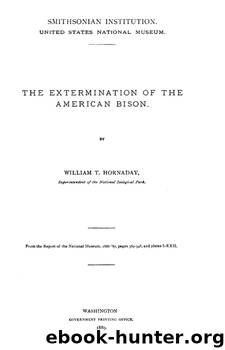The Extermination of the American Bison by William T. Hornaday

Author:William T. Hornaday
Language: eng
Format: epub
Publisher: Government Printing Office
Published: 1889-12-08T16:00:00+00:00
Still-hunting Buffaloes on the Northern Range. From a painting by J. H. Moser, in the National Museum.
Having secured a position within from 100 to 250 yards of his game (often the distance was much greater), the hunter secures a comfortable rest for his huge rifle, all the time keeping his own person thoroughly hidden from view, estimates the distance, carefully adjusts his sights, and begins business. If the herd is moving, the animal in the lead is the first one shot, close behind the fore leg and about a foot above the brisket, which sends the ball through the lungs. If the herd is at rest, the oldest cow is always supposed to be the leader, and she is the one to kill first. The noise startles the buffaloes, they stare at the little cloud of white smoke and feel inclined to run, but seeing their leader hesitate they wait for her. She, when struck, gives a violent start forward, but soon stops, and the blood begins to run from her nostrils in two bright crimson streams. In a couple of minutes her body sways unsteadily, she staggers, tries hard to keep her feet, but soon gives a lurch sidewise and falls. Some of the other members of the herd come around her and stare and sniff in wide-eyed wonder, and one of the more wary starts to lead the herd away. But before she takes half a dozen steps “bang!” goes the hidden rifle again, and her leadership is ended forever. Her fall only increases the bewilderment of the survivors over a proceeding which to them is strange and unaccountable, because the danger is not visible. They cluster around the fallen ones, sniff at the warm blood, bawl aloud in wonderment, and do everything but run away.
The policy of the hunter is to not fire too rapidly, but to attend closely to business, and every time a buffalo attempts to make off, shoot it down. One shot per minute was a moderate rate of firing, but under pressure of circumstances two per minute could be discharged with deliberate precision. With the most accurate hunting rifle ever made, a “dead rest,” and a large mark practically motionless, it was no wonder that nearly every shot meant a dead buffalo. The vital spot on a buffalo which stands with its side to the hunter is about a foot in diameter, and on a full-grown bull is considerably more. Under such conditions as the above, which was called getting “a stand,” the hunter nurses his victims just as an angler plays a big fish with light tackle, and in the most methodical manner murders them one by one, either until the last one falls, his cartridges are all expended, or the stupid brutes come to their senses and run away. Occasionally the poor fellow was troubled by having his rifle get too hot to use, but if a snow-bank was at hand he would thrust the weapon into it without ceremony to cool it off.
Download
This site does not store any files on its server. We only index and link to content provided by other sites. Please contact the content providers to delete copyright contents if any and email us, we'll remove relevant links or contents immediately.
Giovanni's Room by James Baldwin(6820)
The Plant Paradox by Dr. Steven R. Gundry M.D(2435)
The Stranger in the Woods by Michael Finkel(2330)
Miami by Joan Didion(2166)
Wild: From Lost to Found on the Pacific Crest Trail by Cheryl Strayed(2144)
INTO THE WILD by Jon Krakauer(2088)
Trail Magic by Trevelyan Quest Edwards & Hazel Edwards(2064)
DK Eyewitness Top 10 Travel Guides Orlando by DK(2059)
Vacationland by John Hodgman(2034)
The Twilight Saga Collection by Stephenie Meyer(2029)
Nomadland by Jessica Bruder(1960)
Birds of the Pacific Northwest by Shewey John; Blount Tim;(1876)
The Last Flight by Julie Clark(1839)
Portland: Including the Coast, Mounts Hood and St. Helens, and the Santiam River by Paul Gerald(1821)
On Trails by Robert Moor(1795)
Deep South by Paul Theroux(1718)
Blue Highways by William Least Heat-Moon(1664)
Trees and Shrubs of the Pacific Northwest by Mark Turner(1646)
1,000 Places to See in the United States and Canada Before You Die (1,000 Places to See in the United States & Canada Before You) by Patricia Schultz(1558)
